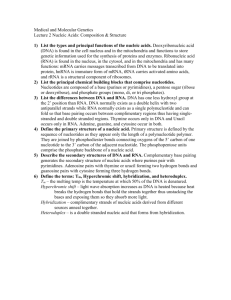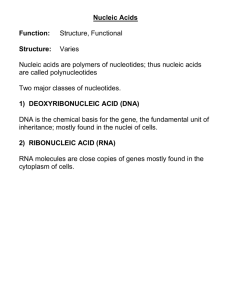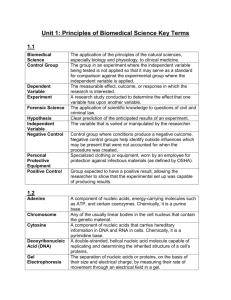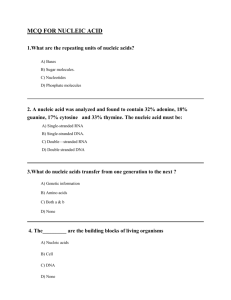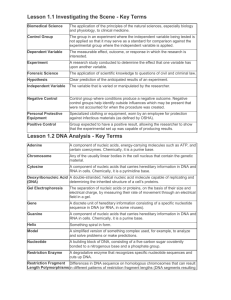Chapter 4
advertisement
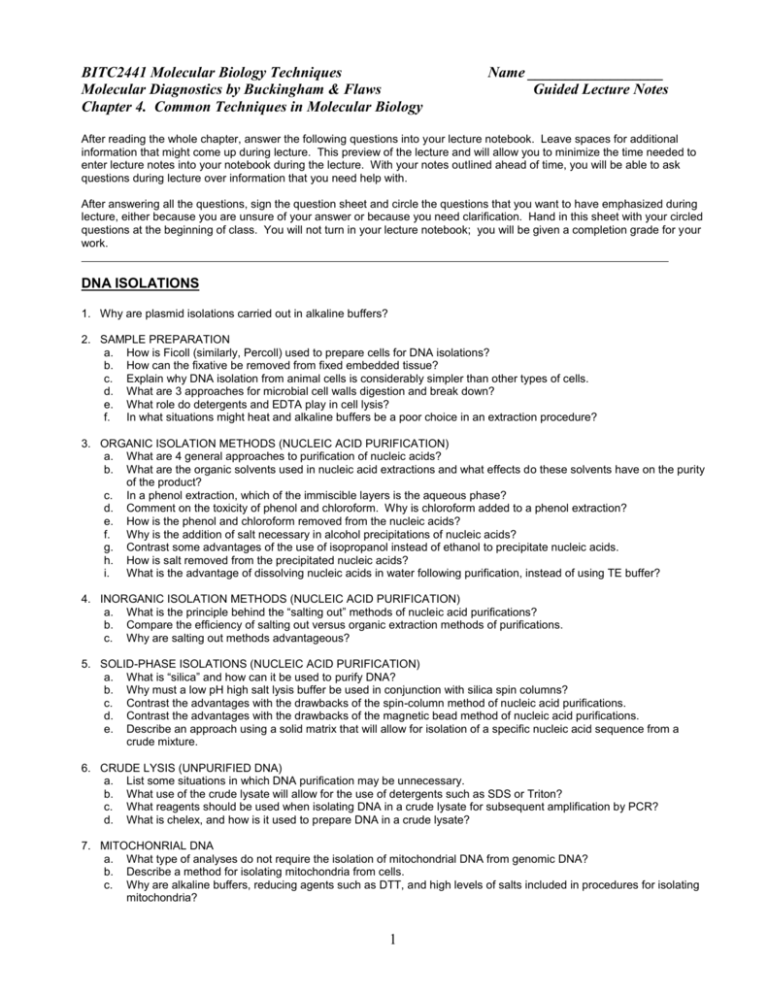
BITC2441 Molecular Biology Techniques Molecular Diagnostics by Buckingham & Flaws Chapter 4. Common Techniques in Molecular Biology Name __________________ Guided Lecture Notes After reading the whole chapter, answer the following questions into your lecture notebook. Leave spaces for additional information that might come up during lecture. This preview of the lecture and will allow you to minimize the time needed to enter lecture notes into your notebook during the lecture. With your notes outlined ahead of time, you will be able to ask questions during lecture over information that you need help with. After answering all the questions, sign the question sheet and circle the questions that you want to have emphasized during lecture, either because you are unsure of your answer or because you need clarification. Hand in this sheet with your circled questions at the beginning of class. You will not turn in your lecture notebook; you will be given a completion grade for your work. DNA ISOLATIONS 1. Why are plasmid isolations carried out in alkaline buffers? 2. SAMPLE PREPARATION a. How is Ficoll (similarly, Percoll) used to prepare cells for DNA isolations? b. How can the fixative be removed from fixed embedded tissue? c. Explain why DNA isolation from animal cells is considerably simpler than other types of cells. d. What are 3 approaches for microbial cell walls digestion and break down? e. What role do detergents and EDTA play in cell lysis? f. In what situations might heat and alkaline buffers be a poor choice in an extraction procedure? 3. ORGANIC ISOLATION METHODS (NUCLEIC ACID PURIFICATION) a. What are 4 general approaches to purification of nucleic acids? b. What are the organic solvents used in nucleic acid extractions and what effects do these solvents have on the purity of the product? c. In a phenol extraction, which of the immiscible layers is the aqueous phase? d. Comment on the toxicity of phenol and chloroform. Why is chloroform added to a phenol extraction? e. How is the phenol and chloroform removed from the nucleic acids? f. Why is the addition of salt necessary in alcohol precipitations of nucleic acids? g. Contrast some advantages of the use of isopropanol instead of ethanol to precipitate nucleic acids. h. How is salt removed from the precipitated nucleic acids? i. What is the advantage of dissolving nucleic acids in water following purification, instead of using TE buffer? 4. INORGANIC ISOLATION METHODS (NUCLEIC ACID PURIFICATION) a. What is the principle behind the “salting out” methods of nucleic acid purifications? b. Compare the efficiency of salting out versus organic extraction methods of purifications. c. Why are salting out methods advantageous? 5. SOLID-PHASE ISOLATIONS (NUCLEIC ACID PURIFICATION) a. What is “silica” and how can it be used to purify DNA? b. Why must a low pH high salt lysis buffer be used in conjunction with silica spin columns? c. Contrast the advantages with the drawbacks of the spin-column method of nucleic acid purifications. d. Contrast the advantages with the drawbacks of the magnetic bead method of nucleic acid purifications. e. Describe an approach using a solid matrix that will allow for isolation of a specific nucleic acid sequence from a crude mixture. 6. CRUDE LYSIS (UNPURIFIED DNA) a. List some situations in which DNA purification may be unnecessary. b. What use of the crude lysate will allow for the use of detergents such as SDS or Triton? c. What reagents should be used when isolating DNA in a crude lysate for subsequent amplification by PCR? d. What is chelex, and how is it used to prepare DNA in a crude lysate? 7. MITOCHONRIAL DNA a. What type of analyses do not require the isolation of mitochondrial DNA from genomic DNA? b. Describe a method for isolating mitochondria from cells. c. Why are alkaline buffers, reducing agents such as DTT, and high levels of salts included in procedures for isolating mitochondria? 1 RNA ISOLATIONS 1. What are some reasons that RNAses pose a special problem in RNA isolation? a. What are some approaches for maintaining RNAse-free glassware? b. Describe the mechanism by which DEPC (diethylpyrocarbamate) renders solutions and surfaces RNAse-free. a. Why should this approach not be taken with Tris buffers or on polystyrene and polycarbonate surfaces? b. What are some alternative RNAse inhibitors? 2. TOTAL RNA a. What proportions of total RNA is rRNA and mRNA? b. Where are mRNAs, tRNAs, and snRNAs located with respect to the rRNA bands on an agarose electrophoresis gel? c. Contrast the approach taken in RNA isolations, compared to DNA isolations, from blood and microbial sources. d. Contrast the components of a lysis buffer in RNA isolations, compared to DNA isolations. e. What is the effect of guanidine thiocyanate on RNAses? f. Contrast the purification methods used in RNA isolations, compared to DNA isolations. g. What are some rough estimates of RNA yields that can be expected from eukaryotic tissue? h. How is glycogen used in RNA isolations? 3. ISOLATION OF mRNA a. What is the approximate yield of mRNA from total RNA when using a polyT or polyU spin column purification? b. Will a polyT or polyU spin column work for mRNA purifications from bacteria? c. What are some potential pitfalls in the use of polyT or polyU hybridization in mRNA purifications? MEASUREMENT OF NUCLEIC ACID QUALITY AND QUANTITY 1. Describe the two general approaches taken to assess the quantity and quality of nucleic acids isolations. 2. What dyes can be used to detect DNA and RNA on electrophoretic gels? a. What does a high quality preparation of DNA or RNA look like on an electrophoretic gel? b. How can electrophoretic gels be made highly quantitative for the concentrations of nucleic acids run on the gels? 3. What are the absorptivity constants for DNA and RNA at 260 nm? a. What is the path length for these constants? b. What effect will phenol and protein residues have of the UV absorbance of nucleic acids? c. What is the linear range of nucleic acids at 260 nm and how do you take measurements of solutions too concentrated for this range? d. What is an acceptable ratio of absorbencies at 260 and 280 nm for a high quality prep of nucleic acids? e. What is the best way to improve purity of a nucleic acid prep that falls outside of this range? f. How is the yield of nucleic acids calculated for an isolation? 4. What are some advantages of the use of fluorometry for nucleic acid quantitation? a. What are some fluorescent dyes used for fluorometric quantitation of DNA and RNA? b. What are some drawbacks of the use of fluorometric quantitations? KEYWORDS supercoiling plasmid DNA Ficoll/Percoll density gradients hypotonic/hypertonic/isotonic paraffin xylene lysozyme zymolyase SDS EDTA Triton X-100 lipids lipoproteins amphiphilic compounds salting out isopropanol/2-propanol diatomaceous earth DNA IQ system proteinase K laser capture microdissection chelex DEPC 2 macaloid clasy DTT β-mercaptoethanol guanidine thiocyanate denaturant glycogen ethidium bromide SybrGreen I & II DABA Hoechst 33258 PicoGreen OliGreen

